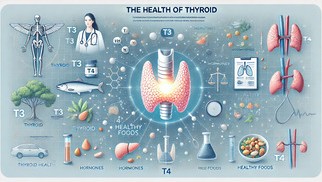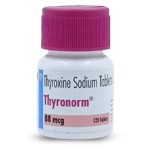Goiter (Thyroid Enlargement): Key Insights and Answers to Common Questions


Goiter, also known as thyroid enlargement, is a medical condition characterized by an abnormal increase in the size of the thyroid gland. The thyroid gland, located at the base of the neck, plays a crucial role in regulating metabolism through the production of hormones such as thyroxine (T4) and triiodothyronine (T3). When the thyroid gland becomes enlarged, it can lead to various health issues, ranging from cosmetic concerns to significant functional impairments. This article delves into the nature of goiter, its causes, the difference between goiter and thyromegaly, the underlying pathophysiology, and the role of Thyroxine Sodium in its treatment.
Symptoms and Causes of Goiter
The symptoms of goiter can vary widely depending on its size, the underlying cause, and the associated thyroid function. Common signs include a visible swelling at the base of the neck, which may be more apparent when swallowing. Some patients experience a tight feeling in the throat, difficulty swallowing or breathing, coughing, and hoarseness of voice. When the goiter is associated with hyperthyroidism, symptoms may include weight loss, rapid heartbeat, and nervousness. In cases of hypothyroidism, fatigue, weight gain, and sensitivity to cold may occur.
The causes of goiter are diverse, with iodine deficiency being a leading global factor. Iodine is essential for the production of thyroid hormones, and its deficiency prompts the thyroid to enlarge in an attempt to capture more iodine from the bloodstream. Autoimmune diseases such as Graves' disease and Hashimoto's thyroiditis are also significant causes. Additionally, hormonal changes during pregnancy, exposure to radiation, and certain medications can contribute to the development of goiter. Genetic factors and dietary influences, including the consumption of goitrogenic foods like soy and cruciferous vegetables in excess, may also play a role.
What Is a Goiter an Enlarged Form Of?
A goiter is essentially an enlarged form of the thyroid gland. The enlargement can occur due to a variety of reasons, including iodine deficiency, autoimmune diseases, and certain genetic conditions. The thyroid gland may enlarge uniformly (diffuse goiter) or develop nodules (nodular goiter). In some cases, the goiter may be associated with normal thyroid function (euthyroid), while in others, it may be linked to hyperthyroidism (overactive thyroid) or hypothyroidism (underactive thyroid). The severity of symptoms and the need for treatment depend on the size of the goiter and its impact on thyroid function and surrounding structures.
What Is the Difference Between Goiter and Thyromegaly?
The terms goiter and thyromegaly are often used interchangeably, but there is a subtle difference between them. Goiter specifically refers to an enlargement of the thyroid gland, which may occur due to a wide range of pathological conditions, including iodine deficiency, Graves' disease, and Hashimoto's thyroiditis. Thyromegaly, on the other hand, is a more general term that simply denotes an increase in the size of the thyroid gland, regardless of the underlying cause. In clinical practice, the term goiter is more commonly used, particularly when the enlargement is due to thyroid pathology.
Is Goiter Hyperplasia or Hypertrophy?
Goiter can result from both hyperplasia and hypertrophy of the thyroid gland cells. Hyperplasia refers to an increase in the number of thyroid cells, often in response to increased thyroid-stimulating hormone (TSH) levels, as seen in iodine deficiency or hypothyroidism. Hypertrophy, on the other hand, involves an increase in the size of individual thyroid cells, which can occur in conditions like Graves' disease where the gland is overstimulated. The overall enlargement of the thyroid in goiter often involves a combination of both processes, depending on the underlying cause and the physiological demands on the gland.
What Is the Pathophysiology of a Goiter?
The pathophysiology of a goiter is complex and varies depending on the underlying cause. In cases of iodine deficiency, the lack of iodine impairs the synthesis of thyroid hormones. This triggers a compensatory increase in TSH secretion by the pituitary gland, which stimulates the thyroid to grow in an attempt to produce more hormones. In autoimmune conditions such as Graves' disease, autoantibodies stimulate the TSH receptor, leading to excessive growth and hormone production. In contrast, in Hashimoto's thyroiditis, chronic inflammation and lymphocytic infiltration of the thyroid can lead to both gland enlargement and eventual hypothyroidism. The enlargement in goiter may also be influenced by local factors such as growth factors, cytokines, and alterations in the thyroid microenvironment.
The Role of Thyroxine Sodium in the Treatment of Goiter
Thyroxine Sodium, a synthetic form of the thyroid hormone thyroxine (T4), plays a significant role in the treatment of goiter, particularly in cases associated with hypothyroidism. When a goiter is caused by an underactive thyroid, Thyroxine Sodium supplementation helps restore normal thyroid hormone levels, which in turn reduces the stimulation of TSH and may decrease the size of the goiter. It is also used in patients with euthyroid goiter to suppress TSH levels and potentially reduce gland size. Long-term therapy with Thyroxine Sodium may also help prevent the recurrence of goiter after surgical treatment or radioiodine therapy. The effectiveness of this treatment depends on careful dose adjustment, as excessive supplementation could lead to hyperthyroidism. Regular monitoring through blood tests and clinical assessments is essential to ensure the safe and effective management of goiter with Thyroxine Sodium. Additionally, in multinodular goiter, Thyroxine Sodium may assist in stabilizing the growth of nodules and reduce the need for invasive treatments. By maintaining balanced hormone levels, this therapy contributes not only to the reduction of goiter size but also to the overall improvement of metabolic stability in affected patients.
Additional Considerations in the Management of Goiter
The management of goiter involves a comprehensive approach that includes identifying and treating the underlying cause of thyroid enlargement. In addition to Thyroxine Sodium therapy, iodine supplementation is recommended in cases of iodine deficiency, especially in regions where iodine intake is low. For patients with hyperthyroid goiter, antithyroid medications, radioactive iodine therapy, or even surgical intervention may be necessary. Surgical removal of the thyroid gland (thyroidectomy) is typically reserved for cases where the goiter is causing compressive symptoms, such as difficulty swallowing or breathing, or if there is a suspicion of malignancy. Post-surgery, patients may require lifelong thyroid hormone replacement therapy.
Final Thoughts
Goiter, or thyroid enlargement, is a condition with diverse causes and manifestations. While it may present as a benign and asymptomatic condition in some cases, it can also lead to significant clinical symptoms and require targeted treatment. Understanding the differences between goiter and thyromegaly, the processes of hyperplasia and hypertrophy, and the pathophysiological mechanisms involved can help in the accurate diagnosis and management of this condition. Thyroxine Sodium remains an important therapeutic option, particularly for goiters related to hypothyroidism or those requiring TSH suppression. As with all thyroid disorders, individualized treatment and careful monitoring are essential to achieve the best clinical outcomes. Effective management of goiter not only improves thyroid function but also enhances the quality of life for patients by alleviating symptoms and preventing complications.
Article post: Editorial Team of RXShop.md
(Updated at Mar 7 / 2025)

